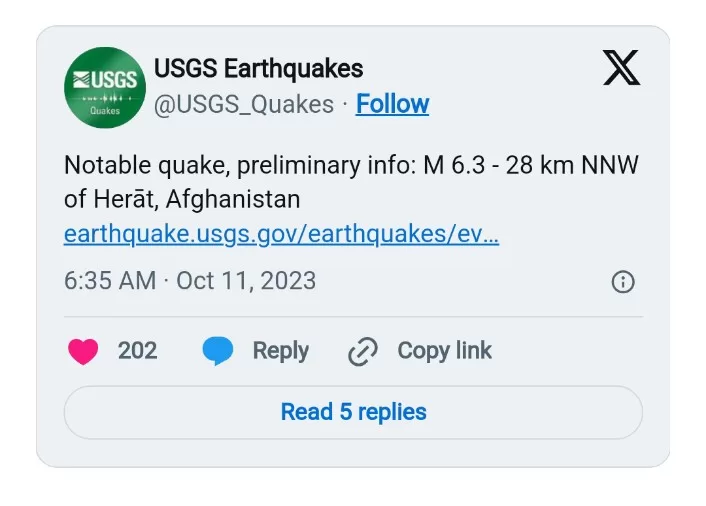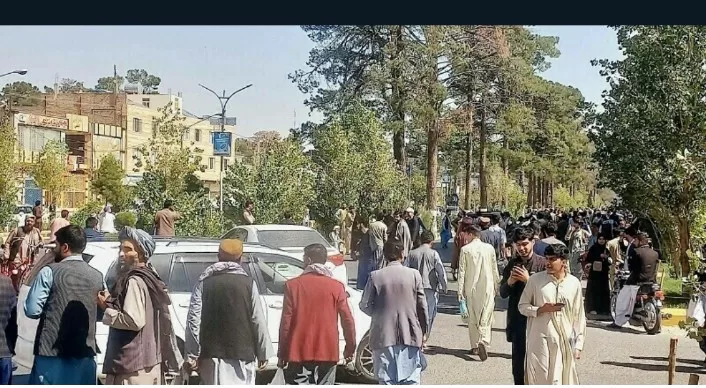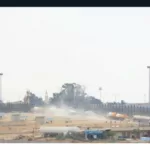A seismic event of magnitude 6.3 has shaken the western region of Afghanistan on a fateful Wednesday morning, exacerbating an already dire situation in an area where more than 2,000 lives were tragically claimed by a series of analogous tremors during the preceding weekend.
The earthquake transpired at a shallow depth, precisely around 5:10 AM local time (12:40 AM GMT), its epicenter located approximately 29 kilometers to the north of the city of Herat, as confirmed by the United States Geological Survey.
In the aftermath of the initial series of seismic disturbances that mercilessly obliterated entire villages and disrupted the lives of more than 12,000 individuals, as estimated by the United Nations, volunteers and rescue teams have been toiling ceaselessly since Saturday, undertaking last-ditch efforts to unearth survivors. The count of casualties and the injured has been a subject of discord between local and national authorities. The disaster ministry, while attempting to provide clarity, reported a grim figure of 2,053 lives lost, though the situation remains in flux, as articulated by disaster management ministry spokesman Mullah Janan Sayeq: “We can’t give exact numbers for the dead and wounded as it is in flux.”
As the news of the most recent earthquake near Herat city surfaced, home to a population exceeding half a million, there were no immediate reports of additional casualties. Details regarding the extent of damage and the impact of this latest seismic event were not readily available, leaving disaster management spokesman Janan Sayeeq unable to provide precise information.
A statement issued by the office of Herat’s governor disclosed that several districts adjacent to the areas already decimated by the preceding earthquakes had incurred significant losses. The statement also mentioned that mobile medical teams, in collaboration with officials, have been tirelessly transporting the injured to hospitals.
The preceding earthquakes had left utter devastation in their wake, obliterating a minimum of 11 villages in Herat province’s Zenda Jan district, as attested by the United Nations. The heart-wrenching testimonial of a 40-year-old survivor, Mohammad Naeem, illuminated the profound human tragedy that unfolded: “Not a single house is left, not even a room where we could stay at night. We can’t live here anymore. You can see, our family got martyred here. How could we live here?”
Due to the persistent fear of aftershocks stemming from the seismic upheaval over the weekend, local media reported that many residents of Herat resorted to living in tents, seeking refuge in the open air during the nighttime.
This poignant humanitarian crisis presents a monumental challenge to the Taliban authorities in Afghanistan, who took control of the nation in August 2021 and find themselves in strained relations with international aid organizations. Afghanistan, long accustomed to the scourge of deadly earthquakes, is particularly vulnerable due to the prevalent construction of homes in rural areas, predominantly comprised of mud with minimal steel or concrete reinforcement. Multi-generational extended families commonly reside under one roof, leaving communities exceedingly vulnerable to the devastation wrought by substantial seismic events.
The affliction of Afghanistan’s humanitarian crisis has been compounded by the significant reduction of foreign aid following the resurgence of the Taliban. Notably, Herat province, nestled on the border with Iran, is home to approximately 1.9 million people, and its rural communities have been grappling with a protracted drought, further intensifying their plight. This seismic tragedy marks the most devastating earthquake to strike the beleaguered nation in over a quarter of a century.







